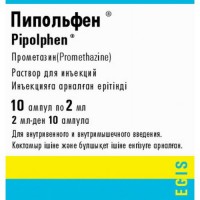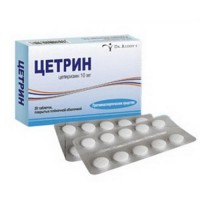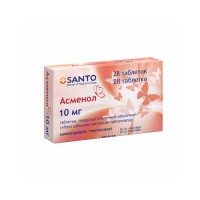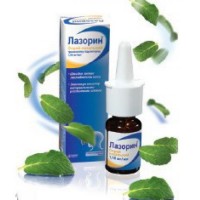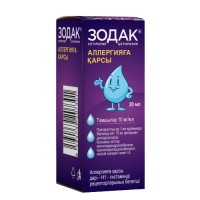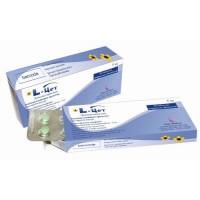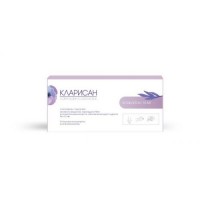Zodak Express 7's 5 mg film-coated tablets
- $5.30
The instruction for medical use of medicine of Zodak® Express Torgovoye nazvaniye Zodak® Express the International unlicensed name Levotsetirizin Lekarstvennaya the Tablet form, film coated, 5 mg Structure One tablet contains active agent - a levotsetirizin dihydrochloride of 5 mg, excipients: lactoses monohydrate (67.5 mg), cellulose microcrystalline, sodium starch glikolit, silicon dioxide colloidal anhydrous, magnesium stearate, structure of a film cover: a gipromelloza 2910/5, a macrogoal 6000, talc, the titan of dioxide (E171) the Description of the Tablet of oblong shape, biconvex, film coated white or almost white color, with stamping е on one party of a tablet Pharmacotherapeutic group Antihistaminic drugs of systemic action. Piperazin derivatives. Levotsetirizin. The ATX R06AE09 code the Pharmacological Pharmacokinetics Pharmacokinetics properties of a levotsetirizin is linear, does not depend on a dose and time, with low variability among patients and also practically does not differ from pharmacokinetics of a tsetirizin. Chiral inversion does not arise in the course of absorption or removal. Absorption After intake drug is quickly and completely soaked up from digestive tract. The maximum concentration in blood is reached less than in an hour (54 min.) after reception. The equilibrium state is reached in two days. The maximum concentration (Cmax) in blood plasma makes 270 ng/ml after single dose and 308 ng/ml after repeated administration of drug in a dose of 5 mg/days. Meal does not affect completeness of absorption though the maximum concentration and speed of its achievement decreases. Distribution Data on distribution of a levotsetirizin in fabrics and about penetration through a blood-brain barrier at the person are absent. Levotsetirizin for 90% contacts proteins of plasma. The volume of distribution is 0.4 l/kg. Metabolism In small amounts (& lt, 14%) is metabolized in an organism by N- and O-dealkylation (unlike other antagonists of H1-histamine receptors which are metabolized in a liver by means of the system of cytochromes) with formation pharmacological of an inactive metabolite. Dealkylation, first of all, is mediated by CYP 3A4, during aromatic oxidation the numerous and/or unknown CYP isoforms participate. Levotsetirizin does not influence activity of isoenzymes of CYP 1A2, 2S9, 2S19, 2D6, 2E1 and 3A4 in the concentration considerably exceeding the peak of the concentration reached at reception of a dose of 5 mg. Because of the low metabolic rate and lack of metabolic potential the interaction of a levotsetirizin with other medicines is represented improbable. Removal At adult patients elimination half-life (T1/2) makes 7.9 ± 1.9 h. Average removal of drug from an organism makes 0.63 ml/min. At the same time 85.4% of the accepted dose of drug are removed by kidneys in not changed look by glomerular filtration and canalicular secretion, about 12.9% – through intestines. Special categories of patients the Renal failure the Clearance of a levotsetirizin is directly interconnected with clearance (removal) of creatinine. Thus, it is recommended to correct intervals between reception of a levotsetirizin on the basis of clearance of creatinine for patients with a moderate or heavy renal failure. At patients on an end-stage of a disease of kidneys as an anuresis the removal of drug from an organism decreases approximately by 80% in comparison with healthy subjects. Less than 10% of a levotsetirizin are removed from an organism during the standard 4-hour procedure of a hemodialysis. Elderly people the Dosage of a levotsetirizin has to be corrected according to renal function of elderly patients. An abnormal liver function Pharmacokinetic properties of a levotsetirizin at subjects with a liver failure were not studied. The pharmacodynamics Active agent of drug – levotsetirizin, R-enantiomer of a tsetirizin, belongs to group of competitive antagonists of a histamine, blocks H1-histamine receptors. The affinity to H1 receptors at a levotsetirizin is twice higher, than at a tsetirizin. Levotsetirizin influences a gistaminozavisimy stage of allergic reactions and also reduces transendothelial migration of eosinophils through skin cells and respiratory organs, reduces vascular permeability, limits release of mediators of inflammation. Levotsetirizin prevents development and facilitates a course of allergic reactions, possesses antiexudative, antipruritic action, reduces formation of allergic rash and an erythema, has practically no anticholinergic and antiserotoninovy effect. In therapeutic doses practically does not render sedation, does not influence QT interval at the ECG. Effect of drug begins in 12 min. after reception of a single dose at 50% of patients, in 1 hour – at 95% and remains within 24 hours. Indications - symptomatic treatment of allergic rhinitis (including constant allergic rhinitis) both urticarias the Route of administration and doses of the Tablet apply inside with food or on an empty stomach, washing down with a small amount of water, not chewing. Adults and teenagers are more senior than 12 years: the recommended daily dose makes 5 mg (1 tablet, film coated). Children from 6 to 12 years: the recommended day dose makes 5 mg (1 tablet, film coated). Elderly patients: correction of a dose is recommended to elderly patients with a moderate and heavy renal failure (see. Adult patients with a renal failure below). Adult patients with a renal failure: intervals between administrations of drug should be established individually, depending on function of kidneys. Recommendations for correction of a dose are given in the table below. To use this table of dosing, assessment of clearance of creatinine of the patient (KK) in KK ml/min. is required (in ml/min.) it can be estimated on creatinine of the serum (mg/dl) determined by the following formula: KK =
x the weight (kg) (x 0.85 for women) 72 x creatinine of serum (mg/dl) Correction of dosing for patients with a renal failure: The Clearance of Creatinine group (ml/min.) the Dosage and frequency Healthy patients of ≥80 5 mg once a day the Moderated renal failure of 50 - 79 5 mg once a day the Average renal failure of 30 - 49 5 mg once in 2 days the Heavy renal failure & lt, to 30 5 mg once in 3 days the End-stage of a renal failure – patients on dialysis & lt, 10 It is contraindicated for use Children with a renal failure: the dose has to be corrected on an individual basis taking into account renal clearance and the patient's weight. Patients with a liver failure: At the isolated abnormal liver function of dose adjustment it is not required. At patients with hepatonephric insufficiency the dose adjustment is recommended. Use duration Seasonal allergic rhinitis (symptoms & lt, 4 days/week or less than 4 weeks) it is necessary to treat depending on a disease and its history, use of drug can be stopped only after elimination of symptoms. Treatment can be resumed repeated emergence of symptoms again. In case of persistent allergic rhinitis (symptoms & gt, 4 days/week and within more than 4 weeks) continuous therapy can be offered the patient during contact with allergens. For a chronic small tortoiseshell and chronic allergic rhinitis there is a clinical experience of use of a racemate duration up to one year. Side effects Side effects are provided with the following frequency: Often: ≥1/100 - & lt, 1/10, is rare: ≥1/1000 - & lt, 1/100, is not known: frequency cannot be estimated on the basis of available data. Often – a headache – drowsiness, a sleep disorder – dryness in a mouth – fatigue – diarrhea, vomiting, a constipation Seldom: – an asthenia – an abdominal pain it is not known (post-marketing experience of use) – hypersensitivity, including an anaphylaxis, a Quincke's disease, a resistant medicinal erythema, rash, an itching, a small tortoiseshell – increase in appetite, nausea, vomiting – aggression, excitement, hallucinations, a depression, insomnia, suicide thoughts, spasms, paresthesias, dizziness, a faint, a tremor, a dysgeusia, a spatial disorientation – a disorder of vision, the obscured sight – heartbeat, tachycardia – short wind – hepatitis – a dysuria, an ischuria – muscle pain – swelled – increase in weight, an abnormal liver function the Message about suspicion of development of undesirable reactions the Message about suspicion of development of undesirable reactions at intake of medicine during the post-marketing period is extremely important. It allows to estimate ratios of advantage and risk of medicine. Workers of health care have to report about any suspicions of undesirable medicinal reactions by means of the System of reports on the undesirable phenomena. Contraindications - hypersensitivity to active agent of drug, derivatives of piperazin or any of drug components - a severe form of chronic kidney disease (KK less than 10 ml/min.) - children's age up to 6 years - rare hereditary diseases of intolerance of a galactose, insufficiency of lactase or disturbance of absorption of glucose galactose - pregnancy and the period of a lactation Medicinal interactions These researches of interaction with levotsetiriziny (including researches with the inductors CYP3A4) are absent, researches of connection of a tsetirizin with a racemate did not show any clinically significant adverse interactions (with antipyrine, pseudoephedrine, Cimetidinum, ketokonazoly, erythromycin, azithromycin, glipizidy and diazepam). Small decrease in clearance of a tsetirizin (16%) was observed in a research with repeated doses of theophylline (400 mg once a day) while the susceptibility of theophylline did not change at simultaneous use with tsetiriziny. At simultaneous use of a ritonavir (600 mg twice a day) and a tsetirizina (10 mg a day) extent of influence of a tsetirizin increased approximately by 40%, and distribution of a ritonavir was slightly changed (-11%), because of combined use of a tsetirizin. Extent of absorption of a levotsetirizin does not decrease with meal though the speed of absorption decreases. The racemate of a tsetirizin does not strengthen effect of alcohol, however sensitive patients have a simultaneous use of a tsetirizin or levotsetirizin and alcohol or other depressants of central nervous system can have effect on the central nervous system. The special instructions Use of a Tablet with a film cover it is not recommended for children under 6 years as this dosage form does not allow to adjust a dose. It is recommended to use drug with levotsetiriziny, intended for children. It is not recommended to use drug for children 2 years are younger. Alcohol intake is not recommended. To patients with the contributing factors of an ischuria to accept with extra care (for example, damage of a spinal cord, a prostate hyperplasia) as levotsetirizin can increase risk of development of an ischuria. Excipients Everyone tablets contains 67.5 mg of monohydrate of lactose, patients with rare hereditary diseases of intolerance of a galactose, insufficiency of lactase or disturbance of absorption of glucose galactose should not take this drug. Features of influence of medicine on ability to run the vehicle or potentially dangerous mechanisms At objective assessment of ability to driving of the car and work with mechanisms any undesirable phenomena are authentically not revealed when assigning of the recommended dose of 5 mg. Nevertheless, it is reasonable to abstain from occupations potentially dangerous types of activity demanding the increased concentration of attention and speed of psychomotor reactions as some patients can test drowsiness, fatigue and an asthenia. Overdose Symptoms: symptoms of intoxication in the form of drowsiness, children have a concern and acrimony which is replaced by drowsiness. Treatment: there is no specific antidote. At emergence of symptoms of overdose (especially at children) administration of drug should be stopped, gastric lavage, intake of activated carbon, symptomatic therapy is necessary. The hemodialysis is not effective. The form of release and packing On 7 tablets place in blister strip packagings from PVC/Aclar/PVC/Al or Al/Al the blister. On 1 blister strip packaging together with the instruction for medical use in the state and Russian languages put in a pack cardboard. To Store storage conditions in original packing at a temperature not above 25 °C, in the dry place. To store out of children's reach! A period of storage 2 years not to use after an expiration date Prescription status from drugstore According to the prescription the Producer / Owner of the registration certificate Zentiva to. village, Czech Republic location Address: U kabelovny 130, 102 37 Praha 10, Dolni Mecholupy, Czech Republic the Address of the organization accepting in the territory of the Republic of Kazakhstan claims from consumers on quality of products (goods) of Sanofi-aventis Kazakhstan LLP Republic of Kazakhstan, 050013, Almaty, Furmanov St., 187B phone number: +7 (727) 244-50-96 fax: +7 (727) 258-25-96 e-mail: quality.info@sanofi.com the Name, the address and a contact information (phone, the fax, e-mail) of the organization in the territory of the Republic of Kazakhstan responsible for post-registration observation of safety of medicine of Sanofi-aventis Kazakhstan LLP Republic of Kazakhstan, 050013, Almaty, Furmanov St., 187B phone number: +7 (727) 244-50-96 fax: +7 (727) 258-25-96 e-mail:
To Develop Kazakhstan.Pharmacovigilance@sanofi.com
x the weight (kg) (x 0.85 for women) 72 x creatinine of serum (mg/dl) Correction of dosing for patients with a renal failure: The Clearance of Creatinine group (ml/min.) the Dosage and frequency Healthy patients of ≥80 5 mg once a day the Moderated renal failure of 50 - 79 5 mg once a day the Average renal failure of 30 - 49 5 mg once in 2 days the Heavy renal failure & lt, to 30 5 mg once in 3 days the End-stage of a renal failure – patients on dialysis & lt, 10 It is contraindicated for use Children with a renal failure: the dose has to be corrected on an individual basis taking into account renal clearance and the patient's weight. Patients with a liver failure: At the isolated abnormal liver function of dose adjustment it is not required. At patients with hepatonephric insufficiency the dose adjustment is recommended. Use duration Seasonal allergic rhinitis (symptoms & lt, 4 days/week or less than 4 weeks) it is necessary to treat depending on a disease and its history, use of drug can be stopped only after elimination of symptoms. Treatment can be resumed repeated emergence of symptoms again. In case of persistent allergic rhinitis (symptoms & gt, 4 days/week and within more than 4 weeks) continuous therapy can be offered the patient during contact with allergens. For a chronic small tortoiseshell and chronic allergic rhinitis there is a clinical experience of use of a racemate duration up to one year. Side effects Side effects are provided with the following frequency: Often: ≥1/100 - & lt, 1/10, is rare: ≥1/1000 - & lt, 1/100, is not known: frequency cannot be estimated on the basis of available data. Often – a headache – drowsiness, a sleep disorder – dryness in a mouth – fatigue – diarrhea, vomiting, a constipation Seldom: – an asthenia – an abdominal pain it is not known (post-marketing experience of use) – hypersensitivity, including an anaphylaxis, a Quincke's disease, a resistant medicinal erythema, rash, an itching, a small tortoiseshell – increase in appetite, nausea, vomiting – aggression, excitement, hallucinations, a depression, insomnia, suicide thoughts, spasms, paresthesias, dizziness, a faint, a tremor, a dysgeusia, a spatial disorientation – a disorder of vision, the obscured sight – heartbeat, tachycardia – short wind – hepatitis – a dysuria, an ischuria – muscle pain – swelled – increase in weight, an abnormal liver function the Message about suspicion of development of undesirable reactions the Message about suspicion of development of undesirable reactions at intake of medicine during the post-marketing period is extremely important. It allows to estimate ratios of advantage and risk of medicine. Workers of health care have to report about any suspicions of undesirable medicinal reactions by means of the System of reports on the undesirable phenomena. Contraindications - hypersensitivity to active agent of drug, derivatives of piperazin or any of drug components - a severe form of chronic kidney disease (KK less than 10 ml/min.) - children's age up to 6 years - rare hereditary diseases of intolerance of a galactose, insufficiency of lactase or disturbance of absorption of glucose galactose - pregnancy and the period of a lactation Medicinal interactions These researches of interaction with levotsetiriziny (including researches with the inductors CYP3A4) are absent, researches of connection of a tsetirizin with a racemate did not show any clinically significant adverse interactions (with antipyrine, pseudoephedrine, Cimetidinum, ketokonazoly, erythromycin, azithromycin, glipizidy and diazepam). Small decrease in clearance of a tsetirizin (16%) was observed in a research with repeated doses of theophylline (400 mg once a day) while the susceptibility of theophylline did not change at simultaneous use with tsetiriziny. At simultaneous use of a ritonavir (600 mg twice a day) and a tsetirizina (10 mg a day) extent of influence of a tsetirizin increased approximately by 40%, and distribution of a ritonavir was slightly changed (-11%), because of combined use of a tsetirizin. Extent of absorption of a levotsetirizin does not decrease with meal though the speed of absorption decreases. The racemate of a tsetirizin does not strengthen effect of alcohol, however sensitive patients have a simultaneous use of a tsetirizin or levotsetirizin and alcohol or other depressants of central nervous system can have effect on the central nervous system. The special instructions Use of a Tablet with a film cover it is not recommended for children under 6 years as this dosage form does not allow to adjust a dose. It is recommended to use drug with levotsetiriziny, intended for children. It is not recommended to use drug for children 2 years are younger. Alcohol intake is not recommended. To patients with the contributing factors of an ischuria to accept with extra care (for example, damage of a spinal cord, a prostate hyperplasia) as levotsetirizin can increase risk of development of an ischuria. Excipients Everyone tablets contains 67.5 mg of monohydrate of lactose, patients with rare hereditary diseases of intolerance of a galactose, insufficiency of lactase or disturbance of absorption of glucose galactose should not take this drug. Features of influence of medicine on ability to run the vehicle or potentially dangerous mechanisms At objective assessment of ability to driving of the car and work with mechanisms any undesirable phenomena are authentically not revealed when assigning of the recommended dose of 5 mg. Nevertheless, it is reasonable to abstain from occupations potentially dangerous types of activity demanding the increased concentration of attention and speed of psychomotor reactions as some patients can test drowsiness, fatigue and an asthenia. Overdose Symptoms: symptoms of intoxication in the form of drowsiness, children have a concern and acrimony which is replaced by drowsiness. Treatment: there is no specific antidote. At emergence of symptoms of overdose (especially at children) administration of drug should be stopped, gastric lavage, intake of activated carbon, symptomatic therapy is necessary. The hemodialysis is not effective. The form of release and packing On 7 tablets place in blister strip packagings from PVC/Aclar/PVC/Al or Al/Al the blister. On 1 blister strip packaging together with the instruction for medical use in the state and Russian languages put in a pack cardboard. To Store storage conditions in original packing at a temperature not above 25 °C, in the dry place. To store out of children's reach! A period of storage 2 years not to use after an expiration date Prescription status from drugstore According to the prescription the Producer / Owner of the registration certificate Zentiva to. village, Czech Republic location Address: U kabelovny 130, 102 37 Praha 10, Dolni Mecholupy, Czech Republic the Address of the organization accepting in the territory of the Republic of Kazakhstan claims from consumers on quality of products (goods) of Sanofi-aventis Kazakhstan LLP Republic of Kazakhstan, 050013, Almaty, Furmanov St., 187B phone number: +7 (727) 244-50-96 fax: +7 (727) 258-25-96 e-mail: quality.info@sanofi.com the Name, the address and a contact information (phone, the fax, e-mail) of the organization in the territory of the Republic of Kazakhstan responsible for post-registration observation of safety of medicine of Sanofi-aventis Kazakhstan LLP Republic of Kazakhstan, 050013, Almaty, Furmanov St., 187B phone number: +7 (727) 244-50-96 fax: +7 (727) 258-25-96 e-mail:
To Develop Kazakhstan.Pharmacovigilance@sanofi.com

